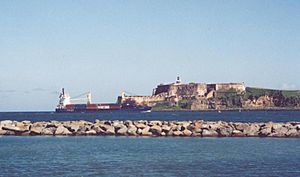Battle of San Juan (1595) facts for kids
Quick facts for kids Battle of San Juan (1595) |
|||||||
|---|---|---|---|---|---|---|---|
| Part of the Anglo-Spanish War (1585–1604) | |||||||
 Ship entering the San Juan Bay, in front of Fort San Felipe del Morro - view from Isla de Cabras. |
|||||||
|
|||||||
| Belligerents | |||||||
| Commanders and leaders | |||||||
| Admiral Pedro Tello de Guzmán Admiral Gonzalo Méndez de Cancio Capt. Sancho Pardo Donlebún Governor Pedro Suárez Coronel |
Francis Drake | ||||||
| Strength | |||||||
| 5 frigates 700 soldiers and 800 sailors 70 land-based guns |
25 ships 2,500 soldiers and sailors |
||||||
| Casualties and losses | |||||||
| 1 frigate burnt 40 killed |
8–10 ships sunk 400 killed |
||||||
The Battle of San Juan (1595) was an important victory for Spain during the Anglo–Spanish War. This war began in 1585 and was fought in Europe and in Spain's American colonies.
After a major defeat in 1589, the English commander Francis Drake led a new campaign. On November 22, 1595, Drake and John Hawkins tried to attack San Juan, Puerto Rico. They had 27 ships and 2,500 men.
Drake first tried to land at Ensenada del Escambron but failed. Then, he tried to sail into San Juan Bay to capture the city. The English could not take the island. After John Hawkins died, Drake left San Juan. He then sailed to Panama, where he later died from illness.
Contents
Why the Battle Happened
Queen Elizabeth I of England wanted to weaken Spain. She sent Sir Francis Drake and Sir John Hawkins on a mission. Their goal was to attack Spanish strongholds like Puerto Rico and Panama. These places were important sources of Spain's gold and silver.
The English fleet left Plymouth on August 28, 1595. They had 27 ships and 2,500 men. Before this, a Spanish fleet was sailing from Havana to Spain. This fleet carried 2,000,000 pesos in gold and silver. A storm damaged their ships, so they went to Puerto Rico for repairs.
The treasure was stored safely in La Fortaleza. Admiral Pedro Tello de Guzmán was sent to get the treasure. On his way, Tello captured one of Drake's ships. He learned about Drake's plan and quickly sailed to Puerto Rico. He arrived before Drake.
The Battle Begins
General Sancho Pardo Osorio led the Spanish land defenses. Admiral Gonzalo Mendez de Cauzo commanded the forts. Admiral Tello defended the harbor with his five frigates. The Spanish sank two ships at the harbor entrance. Tello's frigates were positioned right behind them. This was to stop the English from entering the harbor.
The Spanish defense had 1,500 men. About 800 of them were on the 5 frigates. They also had 70 cannons on land, plus those on the ships. John Hawkins had died on November 12 from a fever. Drake arrived off Puerto Rico on November 22. He anchored near the Boquerón Inlet.
Spanish cannons hit Drake's ship, the Defiance. Sir Nicholas Clifford and Browne were killed. Drake moved his fleet closer to Isla de Cabras on November 23.
The Fight in the Harbor
On the night of November 23, the English attacked the port. They used 25 boats, each with 50 or 60 armed men. Their goal was to burn the Spanish frigates. The boats came close to the fort's battery.
Most boats attacked the Capitana frigate, trying to set it on fire. The Spanish quickly put out the flames. The fight involved cannons, muskets, and stones. The English also set fire to the Sta. Ysabel and Magdalena frigates. The fire on the Magdalena could not be put out. The ship burned fiercely.
The battle lasted about an hour and was very intense. The burning frigate lit up the whole port. This helped the Spanish aim their cannons and muskets. The English lost 9 or 10 boats and over 400 men. Many more were wounded. The Spanish lost one frigate and 40 men. A few more were wounded.
On November 25, Drake's fleet gave up the fight and left.
After the Battle
The Spanish treasure fleet finally left Puerto Rico on December 20, 1595. They sailed safely to Spain.
This defeat ended England's hopes of setting up a base in the Caribbean Sea. Drake also tried to cross the Isthmus of Panama in January 1596. That attempt also failed. Drake then became ill with dysentery. He died on January 28 and was buried at sea.
Popular Culture
The Battle of San Juan is mentioned in Lope de Vega's poem La Dragontea.
See also
 In Spanish: Batalla de Puerto Rico para niños
In Spanish: Batalla de Puerto Rico para niños
Images for kids
-
Ship entering the San Juan Bay, in front of Fort San Felipe del Morro - view from Isla de Cabras.


